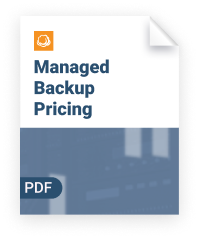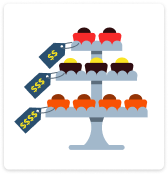MSP Business
MSP Pricing: The Startup Guide
The success of pitching your managed service offerings has a lot to do with pricing. You can have the most amazing grouping of services, but if the cost seems too high or low, customers will pass. Pricing is how potential customers determine whether the service has merit and fits their budget. It can literally be the deciding factor between a customer moving ahead and signing up, and one that passes on the service offering. In short, it’s really important to get the MSP pricing right.
So, what kinds of common MSP pricing models are used today?
MSP Pricing Models
There are two common MSP pricing models: all you can eat and break-fix.
All You Can Eat
 This flat monthly fee-based model usually covers all remote and on-site support. The simplicity in the MSP pricing is attractive to customers looking to avoid complex pricing structures and understand what they’re getting for their money.
This flat monthly fee-based model usually covers all remote and on-site support. The simplicity in the MSP pricing is attractive to customers looking to avoid complex pricing structures and understand what they’re getting for their money.
 Per-Device – this type of MSP pricing means that a flat fee per month is charged is based on the number of devices you are asked to support. It’s beneficial to both you and the customer, as it properly estimates the amount of work being done over time. Some MSPs charge one rate for endpoints and another rate for servers.
Per-Device – this type of MSP pricing means that a flat fee per month is charged is based on the number of devices you are asked to support. It’s beneficial to both you and the customer, as it properly estimates the amount of work being done over time. Some MSPs charge one rate for endpoints and another rate for servers.
 Per-User – a flat fee per month is charged per user. This pricing would include servicing both endpoints and servers, as the individual user accesses both.
Per-User – a flat fee per month is charged per user. This pricing would include servicing both endpoints and servers, as the individual user accesses both.
As both are viable options, it should be addressed when is each mode of MSP pricing appropriate?
For small clients, the cost ends up being very similar between the two options. But it makes sense to charge all services per-device for clients that have a material percentage of their employees that don't use a computer for any of their daily tasks – such as a manufacturer.
On the other hand, there are some thoughts on why “per-device” MSP pricing model might be not a good idea:
- Counting devices may get harder (as cloud services evolve, some devices simply become instances of some device or service in the cloud) and you as an MSP will have to manage all these devices as you manage hosted email or spam filtering. Now you can not just walk around the office and count the devices and this problem multiplies.
- Many users have more than one device and the owners and managers usually want MSPs to manage all these devices. But they don’t want to pay MSP for taking care of the average employee laptop or tablet.
- Some devices are less complicated than others. Laptops and computers obviously need more MSP time and efforts than devices like cell phones. Supporting a computer requires taking care of the operating system, office software, peripheral devices, drivers, etc. As for the average cell phone, MSP usually only makes sure antivirus is working and there is not much to do. So it’s better to create two big categories: computers and everything else.

Tiering All You Can Eat Pricing
 Some MSPs choose to offer tiered pricing as a way to keep the simplified pricing this model affords, but break out advanced services into optional offerings. Most MSPs include services like Remote Monitoring & Management (RMM), maintenance, and support into one offering. Additional tiers could include backup, disaster recovery, archiving, and security services, available at an additional cost. The goal is to keep it simple – use “good, better, best” lines of thinking when crafting your MSP pricing tiers.
Some MSPs choose to offer tiered pricing as a way to keep the simplified pricing this model affords, but break out advanced services into optional offerings. Most MSPs include services like Remote Monitoring & Management (RMM), maintenance, and support into one offering. Additional tiers could include backup, disaster recovery, archiving, and security services, available at an additional cost. The goal is to keep it simple – use “good, better, best” lines of thinking when crafting your MSP pricing tiers.
Break-Fix
 This second MSP pricing model allows the customer to “pay-as-they-go”. Using a pre-defined rate sheet, your customers can utilize discrete services, as desired, that focus on their specific needs, rather than paying a fixed monthly cost. Should you go this route, we encourage you to attempt to use value-based pricing over time-based pricing as a way to both demonstrate value and ensure more profit.
This second MSP pricing model allows the customer to “pay-as-they-go”. Using a pre-defined rate sheet, your customers can utilize discrete services, as desired, that focus on their specific needs, rather than paying a fixed monthly cost. Should you go this route, we encourage you to attempt to use value-based pricing over time-based pricing as a way to both demonstrate value and ensure more profit.
Which MSP Pricing Model Is Right for You?
Although the All You Can Eat model is popular, many MSPs use both models as part of their business, performing break-fix for some clients that don’t want to pay more than the services they get. But, according to one MSP, the long-term goal should be to get away from break-fix:
“Every MSP is trying to get away from break-fix because it's not the most stable and reliable source of income. Unfortunately, we still have cause to do it,” says Kenny Grayson, owner of Grayson Data Services. “But, we’ve found the more that you can bundle together different services to offer, you actually add value. For a fixed cost per month, we are including a spam filter, email security, and backup. You obviously would make more per hour essentially if someone called you for a break-fix type a job, but that's just not steady money and isn’t long-term thinking.”
Further reading MSPs Guide to Upsell


How Should You Determine Price?
At a high-level, MSP pricing is based on three things: your cost of service, the desired profit margin, and the current market influence.
The cost of your services is determined by the technology and people necessary to deliver the service.
Start with what your RMM, email security, antivirus, or backup vendor charges you for their services – and this may go down in total cost as you increase the number of clients using a given vendor’s services.
You’ll need to add in the cost of personnel (both tech and back-office) as well, keeping in mind that no one is 100% utilized. Add these costs up and figure out a cost that aligns with how you’ll price services – per hour, per user, per device, etc.
With cost determined, keep in mind that you can only charge what the market will bear. So, identify what’s being charged by your competition, keeping in mind that the vertical serviced, and the services offered all tie into the market pricing. Listen to customer feedback; if you continually hear your prices are too high, they are.
Further reading MSP Pricing FAQs: The Fundamentals Explained
Correct MSP Pricing = Success
There’s a lot more that can be discussed around MSP pricing. But this article provides a solid overview of some of the areas you need to be thinking about as you work towards establishing proper pricing. Offering services using a pricing model that demonstrates value to the customer will help to ease their concerns and begin to build the relationship. And a pricing model that has solid profit margins is one that is going to carry you toward growth.
To find out which MSP pricing model suits you best, take the time to determine exactly what your clients need and what you can offer them. Don’t offer your clients 24/7 support unless you have specialists that are ready and willing to work on-call at all hours of the day or night. If your resources allow you to provide best-in-class service, then go for it—and plan and price accordingly.
So, before you do anything, get your MSP pricing right.


